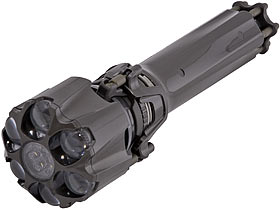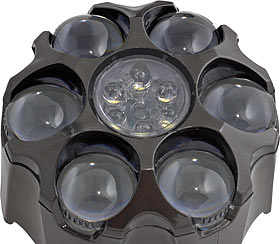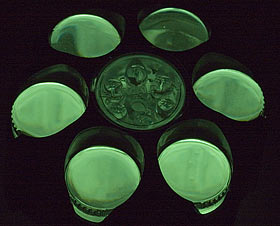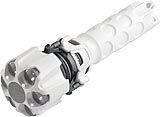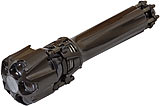
Quick Shot review 26:
LumaRay FL12 LED flashlight
Review date: 22 September 2005.
Last modified 03-Dec-2011.
I reviewed LumaRay's strange, yet unexpectedly non-awful, FL6 flashlight a little while ago.
Here's big brother.
The FL12 is, in almost every respect, exactly the same as the FL6. Same sci-fi body, same three-C-cell battery compartment, same switch and head retaining mechanism that teeters somewhere between form-following-function and techno-sculpture.
But in the middle of the head, where the FL6 just has a little plastic plate with the maker's name on it, the FL12 has another six LEDs.
The outer LEDs on both flashlights have large lenses over the top of them that concentrate their light into a tightly defined 15 degree beam (with a bit of decorative chromatic aberration around the edge), but the FL12's extra LEDs are plain 5mm units, with nothing but their standard little resin lenses.
Because the tight beam is so bright, though, the more diffuse light from the extra LEDs doesn't obviously change the FL12's beam profile. At a glance, you'd still think this flashlight was throwing a simple circle of light. The FL6 has virtually no side spill, though; you get the circle, and that's about it. The FL12 has a faint halo around the main beam.
The FL12's Unique Selling Point is much more obvious when you point it at a light meter.
From fresh batteries at one metre, the FL6's brightness peaks at about 430 lux. If you assume minimum useful illumination is the approximately one lux of moonlight, the FL6's fresh-battery beam is therefore useful out to a distance of about 20 metres.
The FL12 manages about 900 lux at one metre. That gives it about 30 metres of beam throw.
You wouldn't expect the extra LEDs, with their more diffuse output, to be contributing more light to the centre beam than are the big-lensed LEDs around them. And they're not. All of the LEDs in the FL12 are members of a superior strain of diode; they're the new-model double-brightness Nichia CS models, as seen in recent Photon lights. Actually, LumaRay assure me they're the very brightest "U" bin versions, but even if they were cheaper CS LEDs, they'd still be much more efficient (or, to be less colloquial about it, have unusually high luminous efficacy) than their predecessors in the small-LED market.
The CS LEDs also work much better from low batteries.
At 2.8 volts (0.93 volts per cell, which for nominal-1.5V alkalines is well on the way to flatness {PDF}), the FL6 sags right down to a miserable two lux. If a 2-lux-at-one-metre light's all you've got, then it's certainly a heck of a lot better than nothing to keep you company in that cave, capsized boat or spacecraft belonging to aliens who only see infra-red. The FL12 manages 20 lux from the same voltage, though, allowing you to see the freaky creatures much better.
This explains the peculiar low-brightness run time numbers that LumaRay quote for their products. The mildly arbitrary "high brightness" run time for the FL6 is 10 to 15 hours; the FL12 gets eight hours. Fine so far; more LEDs, less run time. The full run time figure for the FL6, though, is about 200 hours, while the FL12 scores 400 hours. Seems like a paradox, but isn't, because of the different behaviour of the better LEDs in the FL12.
You pay, of course, for the privilege; the FL6 sells for $US69.95 plus shipping, while the FL12's $US119.95 plus shipping. When first I spied these prices I thought the FL12 was something of a rip-off (given that the FL6 is already far from the cheapest six-LED light out there, even allowing for its fancy optics), but now that I've got an FL12 to play with, I reckon they both offer about the same value. Yes, six basic high-intensity white LEDs should only cost you, oh, three bucks, tops, but there's a reason why the FL12 price margin is so much bigger.
The FL12 I got for review also has much brighter phosphor-stuff around its outer LEDs than the FL6 I checked out. The big lenses glow much more noticeably after you've been using the light, and the glow is a lot greener, too; the FL6 phosphor-glow is a bluer green.
I don't know whether the phosphor brightness and colour is something of a crapshoot, or whether it's charged up more drastically by the extra LEDs (I doubt that), or whether LumaRay have just improved it for the newer light. This does look like an improved phosphor (which may, of course, be in current FL6s as well), and it makes the flashlight much easier to see at night, as long as it's been on (or brightly illuminated by something else) somewhat recently.
Actually, when your eyes are adjusted to the dark, the FL6 phosphor-glow is somewhat useful as a light all by itself - for a while. If you just want to see where a FL6 or 12 is in a pitch-black place, though, the glow will let you do it for at least a couple of hours after the light's been on for a while.
Overall
As I said in my FL6 review, these flashlights look weird. Really weird. It's not every flashlight company that takes a booth at a Star Trek convention.
And yet - they work. Unlike the movie props they resemble, LumaRay's lights are neither non-functional nor fragile. One of these goofy-looking things could bounce around in your toolbox for years and still function just fine.
If you can't stand the sci-fi look, you don't want a LumaRay. If you just don't care about the look, they're not worth the extra money. But if you think they look nifty, and don't need a wide beam, then neither LumaRay light will disappoint.
Review FL12 kindly provided by LumaRay.
New version
I review the updated "2006" version of the FL6 here.
Little brother
I review the LumaRay FL6 here.
